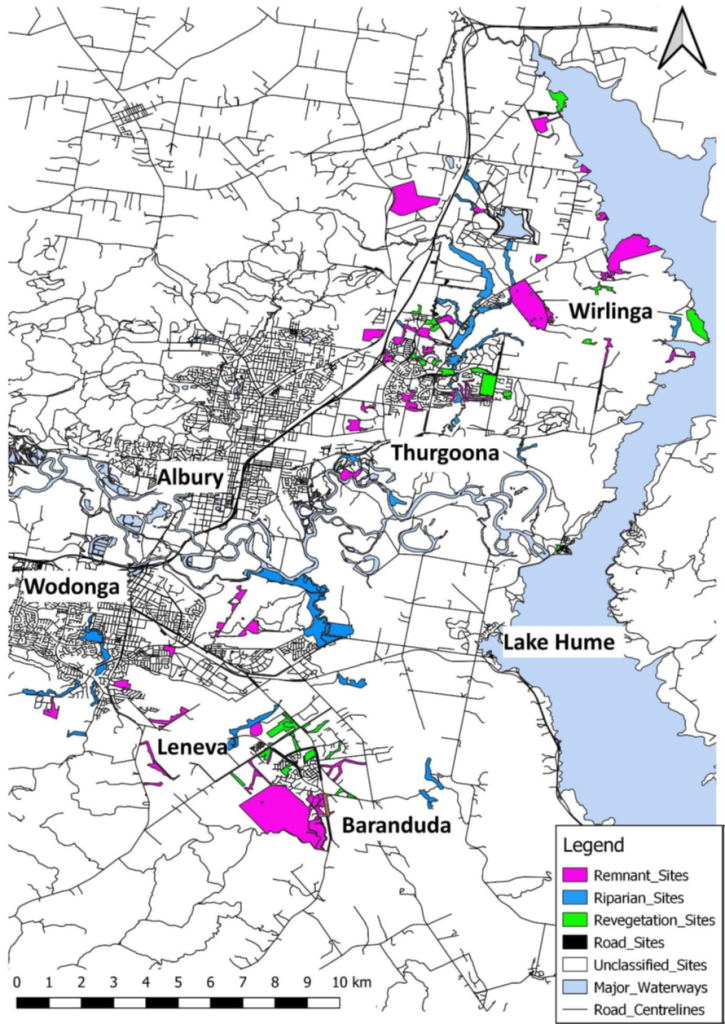Release of 2022 Monitoring report
Albury Conservation Company is very excited to release the 2022 Annual Report for our Threatened Species Monitoring Program. The report documents the monitoring of both sides of the Murray River, covering around 120 sites across the main urban growth areas of Albury (NSW) and Wodonga (VIC)
The Albury Wodonga Threatened Species Monitoring Program (TSMP) has been strategically monitoring Albury Wodonga’s wildlife since 2018, with a focus on arboreal mammals and in particular the Squirrel Glider (Petaurus norfolcensis). Albury Conservation Company (ACC) has engaged DM Ecological to implement the program, which started in Albury (Thurgoona – Wirlinga) and expanded into Wodonga in 2020.

In 2022, the program monitored wildlife at over 120 sites using motion-sensing cameras as the primary survey tool. Two monitoring periods occurred in the Albury (Thurgoona – Wirlinga) study area in 2022, Autumn and Spring. The survey effort in each period was 64 sites and 60 sites monitored respectively. Results showed:
• 27 Squirrel Glider detections in the Autumn monitoring period (detection rate of 42%)
• 19 glider detections in the Spring monitoring period (detection rate of 32%).
Since 2019 gliders have been most frequently detected in riparian sites within the proposed development land use zone. Across the rural and urban land use zones, remnant habitat types have provided the most frequent glider detections. Similarly, gliders have been detected in remnants across all three land use zones during all survey periods, highlighting the importance of this habitat type for the species.
Two monitoring periods occurred in the Wodonga study area in 2022, Autumn and Spring. The survey effort in each period was 59 and 53 sites monitored respectively. Results showed:
• 25 glider detections in the Autumn monitoring period (detection rate of 42%)
• 26 glider detections in the Spring monitoring period (detection rate of 49%)
Roadside and riparian habitat types appear to account for more glider detections in the rural and urban land use zones than they do in the proposed development zone. The habitat types are most often linear in shape and can provide effective wildlife movement corridors throughout highly fragmented landscapes.
Recommended actions include:
- Continue implementing the TSMP in both Thurgoona – Wirlinga and Wodonga to improve knowledge of threatened species and identify critical habitats, linkages, and management interventions to ensure the populations remain viable in the face of urbanisation.
- Detection images captured during the TSMP should be uploaded to the Wildlife Insights artificial intelligence program to assist in the platforms ability to detect and recognise glider species from images captured via motion sensing cameras.
- Prioritise the delivery of the three-year funded ‘Applying science to on-ground action for conservation of Albury Wodonga’s threatened wildlife’ project. In particular, commence monitoring of sites with habitat interventions to facilitate BACI experiment.
- Ensure the timely and effective delivery of the ‘Applying science to inform on-ground actions for conserving Wodonga’s threatened wildlife’.
- This program and its associated projects should be supported by Councils and other key stakeholders. It aligns with the Regional Natural Environment Strategy (RNES) and meets many of the actions in the RNES Action Plan (2020-24).
- The TSMP should collaborate with PhD candidate funded by Albury Conservation Company to ensure beneficial relationship and outcomes for both parties;
- The replacement of twenty cameras should be prioritised by Albury Conservation and its investors to ensure the project can be delivered efficiently.
The Albury Wodonga Threatened Species Monitoring Program has been made possible with funding from Albury City Council, Ross Trust, Wettenhall Environment Trust, Wodonga Council and others.
